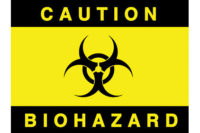Shock: Life and death

Bill, a forklift operator for a local warehouse, isn’tfeeling well. He has Type 2 diabetes and his sugar levels are bottoming out.
He’s sweating profusely and feels lightheaded. A coworker comes over to ask Bill a question but the words aren’t making sense. Looking confused and disoriented, Bill unexpectedly lurches forward and falls to the ground at the feet of his coworker. In moments, he is unconscious and his breathing becomes erratic. Bill has fallen into a diabetic shock. The coworker has no idea what to do and precious seconds tick away as he struggles in vain to wake Bill. After losing vital response time, the worker finally grabs a phone and dials 9-1-1.
Shock is a life-threatening condition that requires immediate medical treatment. It occurs when the body fails to provide enough blood flow to vital organs. Lack of blood flow causes oxygen and nutrition deficiency in cells and organs which can lead to organ failure, and in some cases, even death. According to the National Institute of Health’s MedlinePlus website, as many as 20% of shock victims do not survive.
For first responders, it is important to understand four critical factors – (1) the types of shock conditions that exist, (2) the events that cause shock, (3) how to recognize the signs and symptoms, and (4) how to respond.
There are six main types of shock – neurogenic shock (damage to the nervous system), anaphylactic shock (severe allergic reactions), hypovolemic shock (low blood volume), cardiogenic shock (heart-related), hypoglycemic shock (low blood sugar levels) and septic shock (due to infections). With all shock situations, the condition can spread quickly throughout the body. Response time is critical.
As the nomenclature implies, neurogenic shock arises from damage caused to the nervous system. Injuries to the brain and/or spinal cord are most likely to cause this type of shock. Severe concussions, physical damage to brain tissue and injuries to the cervical or thoracic parts of the spine are all examples of injuries that can lead to neurogenic shock.
Anaphylactic shock is caused by anaphylaxis, which is a life-threatening type of allergic reaction. Anaphylaxis is a whole-body reaction to an allergen such as bee sting or spider bite venom. Some drugs such as morphine and aspirin also can cause anaphylactic-type reactions when a person first is exposed to them.
Hypovolemic shock is caused by blood loss. It occurs when there isn’t enough blood in the body for the heart to pump appropriately. This type of shock often leads to heart problems and can result from internal or external bleeding.
Cardiogenic shock stems from heart-related issues such as heart attack, heart failure and the complications that arise from those conditions. It occurs when the heart has been so severely damaged that it cannot supply enough blood to organs in the body.
Hypoglycemic shock is a condition arising from low blood sugar levels. Victims should raise their blood sugar level quickly because the brain is very susceptible to this condition. If not treated, coma can occur. Diabetes is a disorder that is commonly associated with hypoglycemic issues.
Septic shock is the result of an infection that spreads throughout the body. This type of shock condition leads to dangerously low blood pressure. Septic shock mainly occurs in the elderly and young children but can happen to anyone, especially those with weakened immune systems. Any type of bacteria can cause septic shock. Fungus, viruses and high toxicity levels also can cause septic conditions to arise.
Take action
Recognizing the signs and symptoms of shock can be difficult because they can differ from person to person and can mimic the symptoms of other health issues. In general, one of the more noticeable symptoms of shock relates to a person’s skin. A victim typically has cold and clammy skin. In some cases, it will have a bluish coloring which is especially noticeable on the lips and fingernails. Other signs include chest pain, anxiety, inability to urinate properly, shallow and raspy breathing, dizziness, a rapid but weak pulse, profuse sweating, confusion, mumbling and lightheadedness. If you notice these symptoms, call 9-1-1. Be prepared to give basic life support if needed.
Always check the victim for responsiveness, irregular breathing patterns and any signs of bleeding or injuries. Look for a bracelet or necklace that may indicate a specific medical condition. If life-threatening conditions are noticeable, make the 9-1-1 call.
Critical health issues such as severe bleeding should be treated first. If there is no evidence of trauma, the victim should lie down and then raise his or her legs 6 to 12 in. Support the raised legs to ensure they maintain the elevated position. If the victim is unconscious or vomiting, turn the person’s head to ensure drainage from the mouth. Loosen any tight clothing and, if necessary, maintain the victim’s body temperature by covering him or her with a blanket or coat. Do not let a shock victim eat, drink or smoke. Finally, stay with victim to offer reassurance and comfort until help arrives.
These tips can save a person’s life. For more information, check out the Toolbox Talk at www.asa.net. You also can contact a local medical or emergency services provider for more resources.
Michael Place serves as a training director for Dakota Supply Group and is chairman of the ASA Safety Committee, which produces the Eye of Safety column each month.
Looking for a reprint of this article?
From high-res PDFs to custom plaques, order your copy today!









